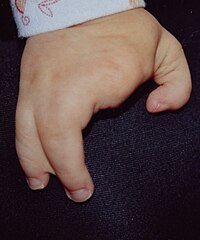
Photo from wikipedia
The objective of this study was to clarify the difference in thumb deformity between our case with ring chromosome 4 and thumb polydactyly, in which ulnar side was small and… Click to show full abstract
The objective of this study was to clarify the difference in thumb deformity between our case with ring chromosome 4 and thumb polydactyly, in which ulnar side was small and had no active motion, and other cases of ring chromosome 4, by analyzing previous reports. Our case had bilateral atypical thumb polydactyly, which was classified as type 4 on the right side and type 5 on the left side, according to the Japanese Society for Surgery of the Hand: Modified International Federation of Societies for Surgery of the Hand classification. Of the 39 cases in previous reports, 20 (51.3%) had thumb deformities. Among them, 19 cases (95%) showed radial ray deficiency and only 1 case (5%) showed bilateral thumb polydactyly. Clinodactyly was seen in 5 cases (12.8%). Foot deformities were present in 6 cases (15.4%). We discussed about thumb polydactyly with and without chromosomal deformities.
Journal Title: The journal of hand surgery Asian-Pacific volume
Year Published: 2018
Link to full text (if available)
Share on Social Media: Sign Up to like & get
recommendations!